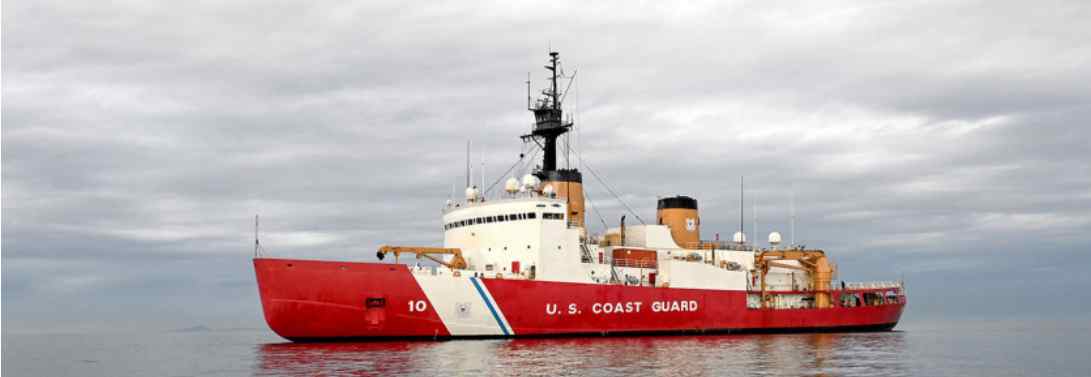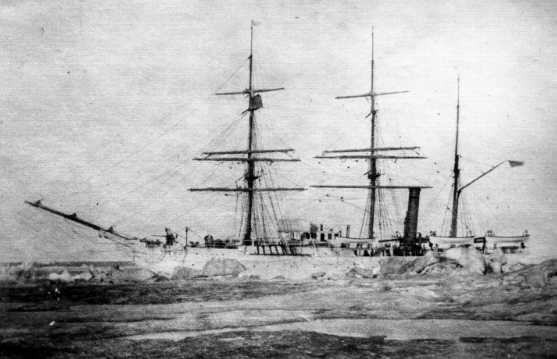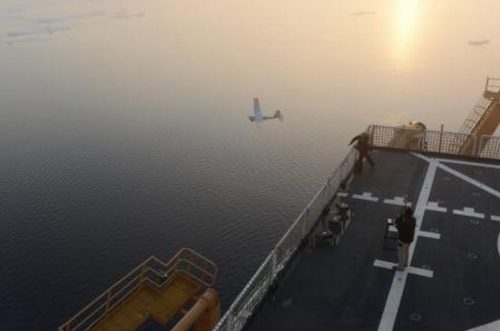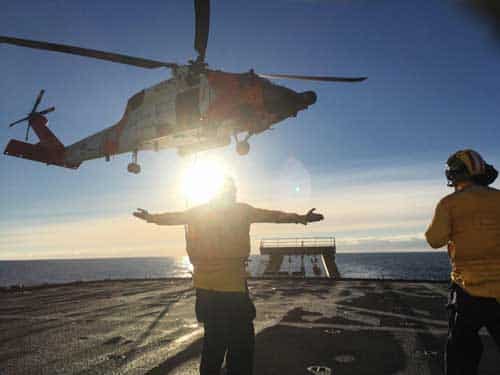
The crew of the U.S. Coast Guard Cutter Healy completed their second mission of their Arctic West Summer 2018 deployment Thursday. Mission 1802 was a scientific mission to study stratified ocean dynamics in the Arctic (SODA) for the Office of Naval Research.
The project, led by Dr. Craig Lee of the Applied Physics Laboratory at the University of Washington, Seattle, aims to better understand how the Arctic environment affects the different water layers of the Arctic Ocean. Understanding these environmental factors may help better predict ice coverage in the region.
Approximately 100 Healy crew members and 30 scientists and engineers departed Dutch Harbor, Alaska, Sept. 14 for SODA. Once in the Arctic Circle, the team deployed an array of scientific equipment, which will monitor the region for the next year and transmit data back to scientists at the Applied Physics Laboratory.
As one of only two icebreakers in U.S. service, the Healy is uniquely suited to support these types of scientific missions in the Arctic. The Healy, a 420-foot icebreaker homeported in Seattle, hosts a full suite of sensors and equipment specifically designed to gather scientific data. Operating from the ship-based Science Technical Support in the Arctic laboratory (STARC), ship personnel provide technical assistance to visiting science teams to collect and gather data such as water conductivity, temperature, depth and sea floor mapping. In 2017, STARC personnel were instrumental in using side-scan sonar to locate the sunken shipwreck of the 110-foot crab fishing boat Destination, which capsized and sank in the Bering Sea, claiming the lives of all six crewmen aboard.
The unique capabilities of the icebreaker, coupled with the expertise of the ship’s crew members, make Healy an ideal choice for missions such as SODA.
[content id=”79272″]
“The Healy is the only vessel we operate as a country that can get us this far into the ice,” Lee said. “If we wanted to come this far up north, we need to have an icebreaker. For the Arctic, the Healy is the only choice other than chartering a vessel from another country.”
The Healy crew is also responsible for the deployment of scientific equipment and for overseeing the safety of the visiting science team – from ensuring no one falls overboard to standing polar bear watch while scientists are on the ice. During the SODA mission, the crew deployed navigation moorings, weather buoys, ice-tethered profilers and autonomous underwater vehicles known as Seagliders, and the crew’s hard work has not gone unnoticed by Lee or his team.
“Our experience on this cruise has been exceptional,” said Lee. “We’ve received fantastic support – not just from a technical standpoint, but people were enthusiastic to get this done. You can tell the crew is focused on helping, rather than just doing their job. They make things efficient, get things done.”
With less ice in the Arctic each year, the human footprint in the region is increasing. Whether it’s tourism, commercial fishing, global shipping or a hunt for natural resources, knowing how Arctic ice forms and recedes gives an edge up to anyone planning to work in the region, which is why the Office of Naval Research has taken notice.
SODA is one of several multi-year studies to determine how to best proceed in the region. Knowing how and when conditions in the Arctic are favorable for transit allows the Department of Defense to plan and prepare for this increased human activity. Knowledge of the changing Arctic environment will ultimately improve our ability to better forecast weather and sea conditions, making it safer for future operations.
This knowledge also allows the U.S. Coast Guard, which leads the Joint Force in the Arctic, to support their full suite of missions in the Polar Regions, including responding to threats, facilitating emerging commercial activities and protecting sovereign rights in the Exclusive Economic Zone and on the Extended Continental Shelf.
Missions such as SODA underscore how important icebreakers are to the national Arctic strategy; that value, however, is threatened by an aging icebreaker fleet.
Presently, the U.S. Coast Guard maintains two icebreakers – the Healy, which is a medium icebreaker, and the Coast Guard Cutter Polar Star, which is a heavy icebreaker. Protecting national interests in the polar regions is essential to ensure the Coast Guard’s national defense strategy and search and rescue capabilities are ready for action, but in order to do so, the icebreaker fleet needs to be modernized.
The 42-year-old Polar Star is showing its age. Reserved for Operation Deep Freeze each year, the Polar Star spends the winter breaking ice near Antarctica in order to refuel and resupply McMurdo Station. When the mission is complete, the Polar Star returns to dry dock in order to complete critical maintenance and prepare it for the next ODF mission. Once out of dry dock, it’s back to Antarctica, and the cycle repeats itself.
If something were to happen to the Healy in the Arctic or to the Polar Star near Antarctica, such as getting stuck in the ice, the U.S. Coast Guard is left without a self-rescue capability, which is why recapitalization of the Polar Security Cutter fleet is so imperative. It’s an initiative that has the attention of the service’s top brass.
“As we move out on recapitalizing our polar icebreaker fleet, I am focused on a 6-3-1 approach,” said Adm. Karl Schultz, commandant of the U.S. Coast Guard. “We plan to build six icebreakers for the high-latitudes, at least three of which will be heavy, but we can’t be in the Arctic the way America needs us unless we build one now.”
By contrast, Russia currently operates 41 icebreakers – several of which are nuclear powered. In order to remain ready, responsive and relevant, recapitalization of the U.S. Coast Guard’s icebreaker fleet is essential if the nation is to be a global leader in the Arctic. Without assets such as the Healy, research projects such as SODA would not be possible, and since SODA may guide the future of the U.S. armed forces and prepare the Coast Guard and DoD to better serve American interests in the region, investment in the icebreaker fleet is imperative. The 6-3-1 approach underscores the importance of protecting U.S. interests in the Arctic, but the U.S. Coast Guard will continue to lag behind countries such as Russia until that first one is built.
The Healy crew returned to Dutch Harbor Oct. 18 and will depart for mission 1803 Oct. 25. The crew is scheduled to return to their homeport in Seattle Nov. 30. To follow the Healy crew on the rest of their Arctic West Summer tour, visit www.Facebook.com/CGCHealy.
Source: USCG








